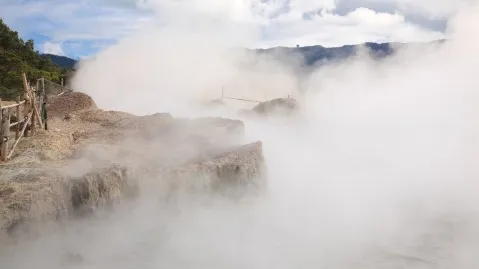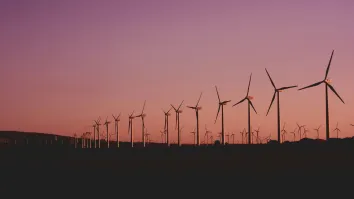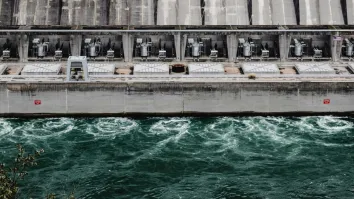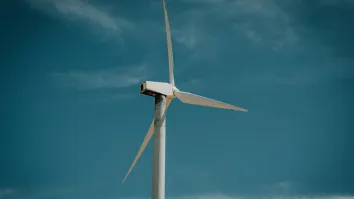
Indonesia is all set to dominate Asia's geothermal power sector by 2024
It's working hard to be in the sector's "hot spot".
Indonesia, is more ways than one, may just find itself in a “hot spot” at present, with much potential simmering just under the cover, waiting to peak in the next few years. Aside from the title of the world’s third-largest geothermal market (second only to the United States and the Philippines), the country’s robust geothermal sector is poised to grow by leaps and bounds in the short-term, thanks to a mix of local and international efforts to boost this sector.
The Government of Indonesia plans to achieve around 6,000 MW of installed geothermal power capacity by 2020, a more than a fourfold increase of the end-2012 capacity of 1,335 MW. This ambitious plan will require strong government support to materialise. Any shortfall in the expansion of geothermal power generation capacity willmost likely be met by additional coal-fired power plants,” says a 2015 joint Asian Development Bank-World Bank (ADB-WB) report entitled “Unlocking Indonesia’s Geothermal Potential.”
For one, industry sources expect Indonesia to take the lead in global geothermal production by the next decade, with capacity seen to account for nearly 90% of Indonesia’s total renewable installed capacity by 2024, says BMI Research in an Industry Trend Analysis report.
“Indonesia's renewables industry expansion will be driven by growth in the geothermal segment, resulting in Indonesia emerging as Asia's largest geothermal market by the end of our forecast period in 2024,” says BMI Research. A burgeoning demand for electricity, coupled with a strong government drive to diversify energy resources, is buoying the country’s geothermal sector, the report noted.
BMI Research expects annual average growth rates in non-hydro renewables generation of 12.1% between 2015 and 2024, resulting in a doubling of non-hydro renewables generation in the country by the end of the forecast period. Similarly, it expects non-hydro renewables capacity to surge from a current level of just under 2GW to 4.4GW by 2024. BMI notes that this growth will be primarily driven by the expansion of Indonesia's already well-developed geothermal industry and it expects geothermal capacity to account for nearly 88% of the total renewables capacity installed in the country by 2024. Much smaller contributions will come from the solar (5%), wind (6%) and biomass (1%) sectors, it says.
A ‘stalled’ sector
Indonesia is located at the convergence of several tectonic plates in Southeast Asia, giving it significant geothermal potential, although most of its potential reserves remain unexplored. According to US Energy Information Administration, Indonesia added about 540 megawatts (MW) of geothermal capacity in the decade leading up to 2013, bringing its installed electric capacity to more than 1.3 GW. Indonesia's current geothermal plants are scattered around Java, North Sumatra, and North Sulawesi and make up less than 3% of total installed generation capacity.
To promote geothermal development, the country's fast-track electrification plan calls for an additional 5 GW of geothermal capacity by 2022, to be operated primarily by IPPs and private companies. The new government's 35 GW Electricity Program, launched in mid-2015, includes 1.2 GW of additional geothermal capacity by 2019. The government signed a cooperation agreement with New Zealand in 2012 for joint development of geothermal energy projects. PT Medco Power Indonesia plans to commission the 330-MW Sarulla power plant, which will be the world's largest geothermal plant by 2018.
Indonesia’s geothermal sector is promising but progress in exploring its huge potential is a mixed bag. While already considered to be a geothermal powerhouse, with geothermal potential estimated at around 28 GW, or 40% of the world’s geothermal potential, utilisation, however, is only at around 1.5 GW. EIA in a report, says that “Indonesia's energy industry has faced challenges in recent years from regulatory uncertainty and inadequate investment.”
“Although Indonesia's electricity generating capacity doubled in the past decade, the country has a low electrification ratio compared to countries with similar income levels. In 2014, about 84% of Indonesia's population had access to electricity compared to less than 68% in 2010,” US EIA analyst Candace Dunn says, citing state-owned electric utility, Perusahaan Listrik Negara.
Indonesia's latest energy policy aims to achieve nearly complete electrification of the country by 2020. In recent years, electricity capacity additions have not kept pace with electricity demand growth, leading to power shortages in grid-connected areas. Dunna adds that inadequate infrastructure as a result of insufficient investment and regulatory hurdles contributes to lower electrification rates, primarily in eastern Indonesia.
Fossil fuels power most of the electricity generation in Indonesia (88%), while renewables, primarily in the form of hydropower and geothermal resources, account for the remainder. Indonesia intends to use domestic fuel sources and diversify its fuel portfolio to include more renewable power. Plans to increase renewable energy use to at least 23% of the energy portfolio by 2025 depend heavily on further developing the country's geothermal and hydropower resources.
According to Dunn, Indonesia has included several geothermal power plants in its fast-track program, which is meant to accelerate the development of more than 27 GW of total power capacity in the next several years. Indonesia has focused on geothermal in particular, signing an agreement with New Zealand in 2012 for joint development of geothermal energy projects.
The ADB-WB joint report is more blunt in its assessment of Indonesia’s geothermal sector, noting widespread perceptions that Indonesia’s geothermal program has essentially “stalled”: “From 2010–2013, just 135 MW was added, and best estimates suggest that by the end of 2016, no more than an additional 190 MW is likely. No power purchase agreements (PPAs) were signed under the 2012 FIT (Feed-In Tariff).
Nevertheless, even with these hurdles, the country’s non-hydro sector—which includes geothermal—is expected to grow by double digits in terms of generation and capacity by the next decade.
“Despite these efforts, progress in the last few years has been slow. The perception that the Indonesian geothermal program has stalled is widespread, and exists among all stakeholders. A step change in the pace of development for even 4,000 MW to be reached by 2020 is therefore required, achievable only by a focused action program by government to resolve institutional, regulatory, and tariff constraints,” says ADB-WB report.
Local policies fueling geothermal growth
What seems to be driving this growth? On the home front, a number of government policies implemented under the administration of President Joko Widodo, elected last year, already seem to be boding well for Indonesia’s geothermal industry, BMI Research notes.
Firstly, a fast-track electrification plan currently calls for an additional 5 GW of geothermal capacity by 2022, to be operated primarily by IPPs (independent power producers) and private companies, in addition to the Widodo administration’s 35 GW electricity program that is expected to add 1.2 GW of additional geothermal capacity by 2019.
On the regulatory side, the adoption of the country’s FiT for geothermal, is expected to offset the high capital costs associated with geothermal development and encourage further investment in the field, and is deemed a good initial step for the geothermal sector.
“The problem of mobilising equity is primarily one of the adequacy of tariffs to enable the upfront equity needed for exploration—much more costly than in other countries where much of the upfront exploration effort was funded as a pure public good,” ADB-WB noted.
General reform on the tariff policy is still needed, however, with ADB-WB recommending tariff-setting to continue by tender, but with improvements to the tendering process and power purchase agreements, and the non-adoption of fixed FITS based on production costs due to their lack of economic efficiency.
BMI Research also agrees that the adoption of a FiT for geothermal is essential given the high capital costs of developing geothermal energy and the government- regulated electricity tariffs which are set artificially low, thus restricting returns on offer and discouraging investment.
Restrictions lifted
In addition, the passage of Indonesia’s geothermal bill last year that reclassifies mining activities, is seen as a step forward as it will ease restrictions on developments in protected forest and conservation areas, where about 60% of Indonesia’s geothermal resources are located, according to BMI Research. Previously, the definition of geothermal development as a mining activity “restricted new projects in conservation areas,” according to US EIA analyst Candace Dunn.
“Indonesia passed a new Geothermal Law in 2014 that eliminated this regulation for geothermal development. The law also attempts to raise investment in geothermal projects by making the price more closely match developments costs. Also, the law limits the permitting process to review only by the central government and alleviates land acquisition issues by providing benefits for the local populations,” Dunn explains.
As a result of these sector-friendly initiatives, Indonesia’s power plant pipeline appears to be full in the near term, another industry group noted.
“More than 60 projects are underway in Indonesia, including 13 geothermal projects in the construction phase on the islands of Java, Sumatra, Sulawesi and Maluku-Ambon, as well as close to 50 projects in early or prospective phases,” according to Yasmin Romitti of the US-based Geothermal Energy Association in a May 2015 report, noting that Indonesia, together with the Philippines and New Zealand, “the South Pacific region has the second-most MW of installed geothermal power capacity behind North America, at 4,318 MW, in addition to the 5,503 MW of developing capacity additions and 9,575 MW of developing resource.”
According to BMI Research, geothermal activities have been lawfully defined as 'mining activities' since 2003 under Law No. 27 2003, preventing development in protected forest and conservation areas which are estimated to contain 60% of the country's geothermal potential.
BMI Research notes that the improving regulatory environment for the Indonesian geothermal sector is evidenced by the growing private sector interest in the market. The country have seen investment announcements by French firm Alstom in February 2015 and Japan-based Inpex Corporation in June 2015. “Overall, we expect geothermal capacity to total 3.8GW by 2024, resulting in Indonesia emerging as Asia's largest geothermal market by installed capacity by the end of our forecast period in 2024,” says BMI Research.
The haze crisis: catalyst for geothermal development
Aside from active state involvement in the geothermal sector, the international community is also being drawn to invest and contribute their share to Indonesia’s geothermal future—driven, in part, by the country’s air pollution woes.
“The southeast Asian haze crisis, driven by slash-and-burn clearing in Indonesia - which has caused severe air pollution in neighboring countries - has turned the spotlight on Indonesia's environmental sustainability practices,” BMI Research said in a separate report. The report went on further to note that, citing the World Resources Institute, Indonesia’s fires have already released more greenhouse gases (GHG) every day compared to the United States.
The Indonesian government is beginning to realise this threat and has identified geothermal energy as a clear alternative to non-renewable resources at present.
“Geothermal energy represents one of the key options for Indonesia to achieve a comprehensive approach to national energy development. The rapid increase in fossil-fuel based energy consumption, which is subject to volatility in the world oil market, is the main challenge facing the country’s energy supply. At the same time, growing GHG emissions from the use of fossil fuels imposes costs on the economy and society,” says Rida Mulyana, directorate general of New, Renewable Energy, and Energy Conservation of Indonesia’s Ministry of Energy and Mineral Resources.
The growing recognition of the emissions problem in Indonesia, catalyzed by the haze crisis and the country's thermal-heavy energy profile, is putting greater international pressure on Indonesia to adopt more stringent environmental policy. According to BMI Research, the Indonesian government already has targets in place to reduce emissions and increase the share of renewable sources in the energy mix. However, it believe this mounting environmental pressure will boost the country's renewable energy industry and facilitate greater inflows of investment from international financial institutions (IFIs) and governments - increasing the chances of these climate change targets to be realised.
“We have already seen this view play out, as the US government announced on 26 October that there would be greater cooperation between both countries in the energy sector, following President Joko 'Jokowi' Widodo's visit to the White House, which he had to cut short due to the haze crisis,” says BMI Research.
The agreement primarily focuses on promoting investment into clean energy technologies, developing policies that reduce GHG and creating risk reduction programmes. BMI Research believes the Indonesia geothermal sector will be a key beneficiary of this partnership, and can capitalise on US companies' wealth of experience in developing geothermal projects. The US is the largest geothermal market in the world by capacity.
Reducing fossil fuel dependence, jumpstarting investments
BMI Research, for its part, has welcomed the Indonesian government’s recent moves to implement emission reduction targets and boost renewable sources in the country’s energy portfolio.
“We believe this mounting environmental pressure will boost the country's renewable energy industry and facilitate greater inflows of investment from international financial institutions (IFIs) and governments - increasing the chances of these climate change targets to be realised,” BMI Research said.
Last October, following President Widodo’s White House visit (cut short due to the haze crisis), the US government pledged cooperation in developing Indonesia’s geothermal industry through major investments in clean energy technologies and the development of policies that aim to reduce GHG, as well as various risk reduction programs.
“We believe the Indonesian geothermal sector will be a key beneficiary of this partnership, and can capitalise on US companies ' wealth of experience in developing geothermal projects. The US is the largest geothermal market in the world by capacity,” BMI Research said.
In the region, the Asian Development Bank has also lent financial muscle to Indonesia’s geothermal development, committing a $350 million financial package for the construction of the 320-MW Sarulla Geothermal Power Development in north Sumatra, expected to be the world’s largest geothermal plant upon its completion in 2018, according to Dunn.
“We expect the Indonesian geothermal industry to be a key recipient of ADB funding over the coming decade, as the development bank targets annual climate financing of $6 billion by 2020,” BMI Research noted.
What else needs to be done?
According to ADB-WB joint report, only concerted and coordinated action in all areas simultaneously will unlock Indonesia’s geothermal sector. The report highlights that the underlying problem is really one of capital mobilization for a generating option that is unusually capital intensive: just to achieve an additional 3,000 MW geothermal capacity in the foreseeable future will require $4 billion in equity and $9.5 billion in debt finance (assuming $4,500/kW total cost, and 30% equity).
“The problem of mobilizing equity is primarily one of the adequacy of tariffs to enable the upfront equity needed for exploration—much more costly than in other countries where much of the up-front exploration effort was funded as a pure public good,” says the report.
The report adds that a key problem for raising debt finance is that even the international financial institutions (IFIs) (ADB,International Finance Corporation, World Bank/International Bank for Reconstruction and Development [IBRD]) are reluctant to fund up-front exploration and typically will provide financing only once 50% or more of the steam resource is proven. “To date, targets for geothermal achievement have not been set with full knowledge of the incremental costs of achieving them,” says ADB-WB report.



















 Advertise
Advertise






